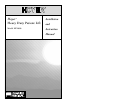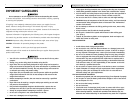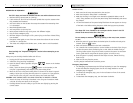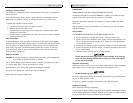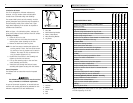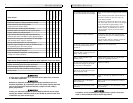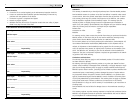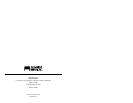
Maintenance
9
MAINTENANCE
ALWAYS CARRY OUT THE DAILY CHECKLIST BEFORE EACH LIFT USE.
HPL600 accessories must be inspected ANNUALLY in addition to the daily and other
periodic visual checks done by the user specified in this section.
Preventive maintenance specified in this manual can prevent accidents and reduce
repair costs.
Note all services or repairs to the HPL600 or its accessories in the log book at the
back of this manual.
Daily Checklist
THE FOLLOWING PROCEDURE MUST BE FOLLOWED BEFORE EACH USE.
• Has the battery been charged? Plug the lift in whenever is not in use.
• Inspect the lift for any damage. If there are any cracks or other damage on the
lift, or any parts are missing– DO NOT USE IT. Contact your local representative
to have the lift serviced.
• Inspect the carry bar for any signs of cracking or damage and that it rotates freely.
• Inspect the actuator on the lift to ensure it is securely attached to the lift and
has no visible damage.
• Make sure casters roll freely and are securely attached.
Inspect the sling for tears, frayed straps or loose stitching. If the sling has
any of the above damage– DO NOT USE IT. Contact your local representative
to have the sling replaced.
Inspection and Cleaning
Clean the lift with a soft dry cloth or a soft cloth lightly moistened with a mild deter-
gent solution. Do not use any type of solvent that may damage the finish.
DO NOT immerse the lift in water.
To ensure a better rolling surface for the wheels, clean them every 4 months. Remove
any hair or debris from the wheel.
To touch-up scratches or chipped paint and retard rust, apply spray paint.
Handling and Storage
Avoid violent shock during transportation.
The lift should not remain stored for long periods of time without recharging the batteries.
Sunrise Medical recommends charging of batteries at least every two weeks even if the
lift is not used. This will prevent premature aging of batteries.
Operation
8
Emergency Lowering Feature
The HPL600 has an emergency manual lowering feature in the event of an electrical or
functional failure.
If the lift malfunctions when a person is being transferred, the emergency manual
lowering device provides a safe way of lowering the person onto a chair or bed.
To operate the emergency lowering feature:
1. Find the red tab on the side of the motor on the lift.
2. Move the person over a bed or chair.
3. Slowly pull down on the ring and hold in place until the person being lifted is
lowered onto chair or bed.
4. Once the person is lowered safely into a chair or bed, take the lift to a certified
technician to be serviced.
Anti-crush Feature
To prevent damage or injury, the motor on the lift has a limit switch that recognizes
when the boom is being lifted or pressed upward. This limit switch will stop the motor
until the boom is no longer being lifted or pressed upward. This will ensure that the
motor stops if the boom is unknowingly being lowered onto an object or person. To
check this feature, press the button on the handset or control box then lift up the
boom. The motor should stop.
Battery Information
CAUTION–
Do not drop the battery. A dropped battery may have internal damage that
is not visible. It may lose its ability to recharge.
Due to internal damage caused when the battery is dropped, the battery may indicate
it is fully charged, when in fact it cannot hold a full charge.
Never attempt to use a battery that appears to be damaged or dented.
Do not store the battery near a heat source. Heat will damage it.
Always keep metal battery contacts clean.



